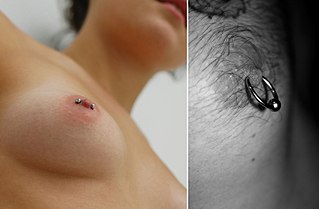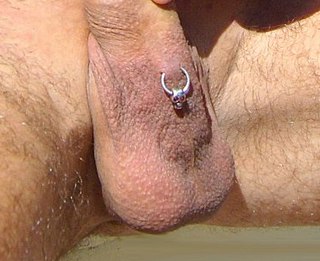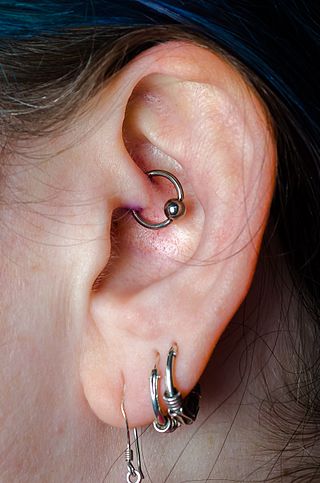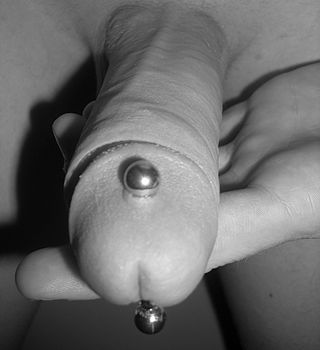
The Prince Albert (PA) is a penis piercing which extends from the urethra to the underside of the glans. It is one of the most common male genital piercings. The related reverse Prince Albert piercing enters through the urethra and exits through a hole pierced in the top of the glans.

A navel piercing is a type of piercing that penetrates the skin of the navel. It is most commonly located on the upper fold of skin but can also be affected underneath or around the edges of the navel. Healing usually takes around 6–12 months but varies person-to-person due to differences in physiology.

A clitoral hood piercing is a female genital piercing through the clitoral hood surrounding the clitoris. In addition to being an adornment, a clitoral hood piercing can enhance sexual pleasure during masturbation, foreplay and intercourse. In an empirical study at the University of South Alabama, the authors reported a positive relationship between vertical clitoral hood piercings and desire, frequency of intercourse, and sexual arousal. There are two main types of clitoral hood piercing: the vertical clitoral hood (VCH) piercing and the horizontal clitoral hood (HCH) piercing. As the names indicate, the difference is in the direction the piercing is oriented in the skin above the clitoris. Neither of these piercings penetrates the clitoris itself, although in common parlance they are sometimes called "clit" piercings. The deep hood piercing is a variation of the clitoral hood piercing that passes deeper through the clitoral hood.

An eyebrow piercing is a vertical surface piercing, wherein a twelve to eighteen gauge cannula needle is inserted through the bottom of the eyebrow and exits through the top of the eyebrow to permit insertion of jewellery. Those performing the piercing may use a pennington clamp to better guide the needle through the skin. A curved barbell is the most common jewellery inserted post-piercing.

A frenum piercing is a type of body piercing located on the underside of the shaft of the penis. A series of parallel frenum piercings is known as a frenum ladder. A frenum ladder may be extended to include lorum piercings, hafada piercings and guiche piercings.

The palang or ampallang is a male genital piercing that penetrates horizontally through the entire glans of the penis.

Genital piercing is a form of body piercing that involves piercing a part of the genitalia, thus creating a suitable place for wearing different types of jewellery. Nevertheless, the term may also be used pars pro toto to indicate all body piercings in the area of the anus, perineum, penis, scrotum, and vulva, including piercings such as anal, guiche, and pubic that do not involve perforation of genitalia. Genital piercings can be done regardless of sex, with various forms of piercings available. The main motive is beautification and individualization; in addition, some piercings enhance sexual pleasure by increasing stimulation. Pre-modern genital piercings is most culturally widespread in Southeast Asia, where it has been part of traditional practice since ancient times. Records of genital piercing are found in the Kama Sutra.

Cock and ball torture (CBT) is a sexual activity involving the application of pain or constriction to the male genitals. This may involve directly painful activities, such as genital piercing, wax play, genital spanking, squeezing, ball-busting, genital flogging, urethral play, tickle torture, erotic electrostimulation, kneeing or kicking. The recipient of such activities may receive direct physical pleasure via masochism, or emotional pleasure through erotic humiliation, or knowledge that the play is pleasing to a sadistic dominant. Many of these practices carry significant health risks.

A hafada piercing is a surface piercing anywhere on the skin of the scrotum. Piercings on the scrotal raphe or "seam" of the scrotum are common. This piercing does not penetrate deep into the scrotum, and due to the looseness and flexibility of the skin in that area, does not migrate or reject as much as many other surface piercings. The main motives are beautification and individualization. A piercing that passes through the scrotum, from front-to-back, or from side-to-side, is known as a transscrotal piercing. Multiple hafada piercings are not uncommon, often as an extension of a frenum ladder or Jacob's Ladder, which is a series of piercings from the frenulum to the scrotum.

A nipple piercing is a type of body piercing, centered usually at the base of the nipple. It can be pierced at any angle but is usually done horizontally or, less often, vertically. It is also possible to place multiple piercings on top of one another.
A transscrotal piercing is a body piercing that travels through the scrotum from front to back, or from side to side. It is a high risk procedure.

James Mark Ward is an American body piercer. In a 2004 documentary, entitled The Social History of Piercing, MTV called him "the granddaddy of the modern body piercing movement."

A lorum is a male genital piercing, placed horizontally on the underside of the penis at its base, where the penis meets the scrotum. The word "lorum" is a portmanteau of the words "low" and "frenum", so named because it is essentially a very low-placed frenum piercing.

A clitoris piercing is a genital piercing placed directly through the head (glans) of the clitoris itself. It is a relatively uncommon piercing by choice because of the potential for nerve damage, and because many may find it too stimulating to allow the constant wearing of a small ring or barbell. Most piercing studios will refuse to do a clitoral piercing. It is often confused with the more common clitoral hood piercing, which pierces only the hood covering the clitoral glans, allowing the jewelry to make only occasional contact with the most sensitive area.

A daith piercing is an ear piercing that passes through the ear's innermost cartilage fold, the crus of the helix.

Chastity piercings are types of genital piercings that can be used to impose chastity in males and females.

An orbital piercing is a combination of two ear piercings connected by one piece of jewelry. Usually located in the helix region of the ear, an Orbital Piercing can be done anywhere on the body including your earlobes. The piercing uses a hoop, and is not to be confused with an industrial piercing, a conch piercing or double cartilage piercing.

In body modification, an implant is a device that is placed under the human skin for decorative purposes. Such implants may be subdermal or transdermal. In the context of body modification, some may consider injections of silicone and other substances a type of implant as well.

The apadravya, like the ampallang, is a genital piercing that passes through the glans. While the ampallang passes horizontally through the glans, the apadravya passes vertically through the glans from top to bottom, almost always placed centrally and passing through the urethra. It can be paired with an ampallang to form the magic cross. Off-center apadravyas are also possible, wherein the piercing is deliberately offset, yet usually still passes through the urethra. The piercing is often done on a slightly forward angle to the hips.






















